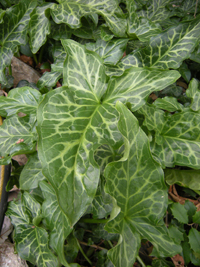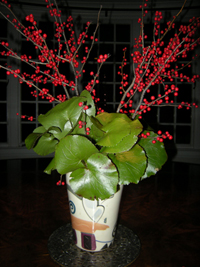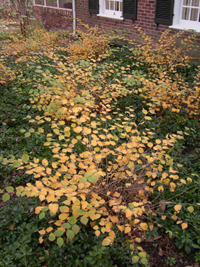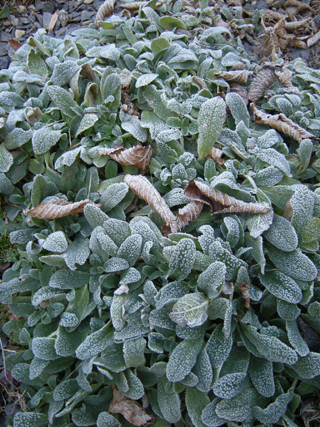Human Flower Project
Unseasonably
Allen Bush describes a late fall and early winter of surprises in the garden, and then the inexorable turn.
 Arum italicum
Arum italicum
Nov. 28, 2009
Louisville, KY, unorthodox holiday greenery
Photo: Allen Bush
By Allen Bush
You can’t fool Mother Nature but you could have fooled me. A few early spring flowering perennials got tricked into late autumn bloom this year. I was delighted with violet colored clusters on Tradescantia virginiana, the Trinity flower (Father, Son and Holy Smoke!). The pink mallow-like blooms of Callirhoe involucrata were nearby. They both popped-out near the back alley, in late November, as the half moon shone bright and the nighttime temperatures hovered in the fifties.
 Galax leaves and Ilex verticillata deck the table
Galax leaves and Ilex verticillata deck the table
Dec. 5, 2009
Louisville, KY
Photo: Allen Bush
The emerging fall foliage on Arum italicum and Cyclamen coum could render traditional Christmas greenery unnecessary. Well, not really. These leaves are beautiful, but I like a cut Fraser Fir Christmas tree and some Galax leaves in the house during the holidays. Either is hard to keep alive in Ohio Valley gardens, but they grow beautifully in the Blue Ridge Mountains. So I cheat. I buy a cut Fraser fir off the lot and mail order a few bundles of Galax leaves.
The round, dark green Galax leaves stay fresh looking indoors for two months when the leaf stems are stood in water. I put these in the same vase with cut stems of the deciduous holly, Ilex verticillata, from the front garden. They’re loaded with berries as red as Santa’s suit.
 Corylopsis spicata sported October color all the way through November this year
Corylopsis spicata sported October color all the way through November this year
Photo: Allen Bush
The fuzzy, gray-green, paddle-shaped leaves of Phlomis samia and the lingering yellow-orange fall leaves of the witch hazel relative, Corylopsis spicata, remained unbitten by freezing cold that should have arrived by early November. My friend Marshall Roberts of Fletcher, North Carolina, used to celebrate these glorious interruptions with remarkable optimism. “It’s just one less day of winter,” he would say. I always felt better hearing these words.
The littler lambs ear, Stachys byzantina ‘Silky Fleece,’ was frost covered on the first morning in December. The car windows needed scraping. Canna musifolia, a ten foot tall species that resembles a banana tree, got burned but wasn’t flattened. The hardier perennial species in the garden were mostly brown and skeletal. I dug-up a few pieces of the Canna to save in the garage but left a few clumps in the ground with dim hope they might survive another winter outdoors. I’ve beaten the odds far longer than I would have imagined. They’ve come back for several years but I like to hedge my bets.
 Stachys byzantina ‘Silky Fleece’ greets December 2009 powdered with frost
Stachys byzantina ‘Silky Fleece’ greets December 2009 powdered with frost
Photo: Allen Bush
I’ve warmed to the possibilities of zone 7, and even zone 8, the last few winters. The ground hasn’t frozen hard for five years in Zone 6 where, on average, the temperature will dip to -10 F (- 23 C). We haven’t had any sustained cold temperatures anywhere close to that. Patches of purple shamrock, Oxalis triangularis, way too tender for most Kentucky winters, have come back each spring thicker than thieves. The frost line is 24”. I’ve been living a fantasy.
The temperature bottomed-out at 20 F (-7 C) on December 6th and a thin sheet of clear ice covered the fish pond. The Canna was crumpled. A knot of chartreuse blooms on Helleborus foetidus ‘Gold Bullion’ was untouched. We had our first dusting of snow the next morning, but worrisome signs had been evident a few months before. The coloring of wooly bear caterpillars in October pointed to a bad winter. Doomsayers like these odd notions. Seldom can they enjoy a spell of good weather without predicting certain misery. I’m not usually stricken by such sentiment but I get their point after a few chilly, gray and drizzly days in early December. Hovering around the shortest day of the year, the mind is vulnerable to omens, and then the cheap car window scrape blade breaks off in your hand.

